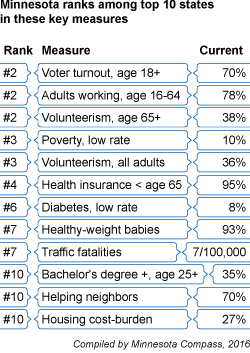For many, the ending of a year is a time of self-reflection. After a(nother) tumultuous year, where do we stand? Where are our strengths? And where are our challenges? Fortunately, here at Minnesota Compass we can look to solid data for these sorts of reflections – at least as they relate to the well-being of communities throughout the state.
As you may know, over the past decade we have worked with advisors to identify "key measures” to help provide a mirror on quality of life in our state. Many of them are comparable state-by-state, lending them to a revealing look at how we stack up.
Strengths
 Very engaged: This November our state was #2 in getting out the vote! Indeed civic engagement is a strength overall whether measured by formal volunteerism (#3 overall and #2 comparing those age 65+) or by general “neighborliness” (#10).
Very engaged: This November our state was #2 in getting out the vote! Indeed civic engagement is a strength overall whether measured by formal volunteerism (#3 overall and #2 comparing those age 65+) or by general “neighborliness” (#10).
Hardworking and prosperous: We come in at #2 for proportion of adults working and #10 for adult educational achievement. Though our $63,000 median household income is ranked 12th, our poverty rate is now the nation’s 3rd lowest, and, although over one-fourth of us are paying too much for our housing, that still places us in rank #10 in terms of low or relatively lower housing cost-burdens. On a per capita basis our state’s Gross Domestic Product just misses the top 10.
Pretty darn healthy: A look at Compass health measures shows we rank an impressive #4 in health insurance coverage (though we drop to #12 for coverage among children), #6 for low rates of diabetes, and #7 in healthy-weight babies. Additionally, though it may be hard to believe given the ice that covers our roadways, we have the nation’s 7th lowest rate of traffic fatalities.
Challenges
Minnesota’s on-time high school graduation rate ranks a surprisingly low #32. This is, in part, due to the fact that Minnesota still appears to have more stringent graduation requirements than most states, but, even among the states with a high bar we rank low.
Even worse: The gaping 37 percentage-point gap in homeownership rates between white households and households of color is the largest gap in the nation. In fact, we see troubling racial disparities when we dig deeper on nearly every key measure.
- We rank #44 in high school graduation rates for Asian students, and even lower for American Indian, African American, and Hispanic students.
- Our top ranked overall employment drops to bottom third among American Indians, Southeast Asians, and both U.S.-born and foreign-born Blacks.
- The median income for Minnesota’s white households is 50 percent higher than for households of color. The poverty rate for Minnesotans of color is 3 times that of white Minnesotans.
- Voting rates of Minnesotans of color are less than half of those for the state’s white population.
Indeed, racial disparities remain among the biggest challenges facing our state at year’s end.
Opportunities for Minnesota in 2017?
The New Year holds many opportunities for our state. I will highlight two that are related to the undeniable trajectory of our state’s demography:
- Given that we are five years into a 20-year stretch where the state’s 65+ population will more than double – and especially given that Minnesotans age 65+ volunteer more actively than any other state besides Utah – we need to figure out how best to capitalize on the amazingly huge army of volunteers that are headed our way.
- Given that we are 26 years into a 45 year stretch where the state’s population of color will increase nearly 6 fold (and continue to grow thereafter) -- and especially given the challenges highlighted above -- pursuing greater racial equity is an opportunity and really a key to securing the state’s overall quality of life.
Craig Helmstetter, Ph.D., is the former Project Director for Minnesota Compass